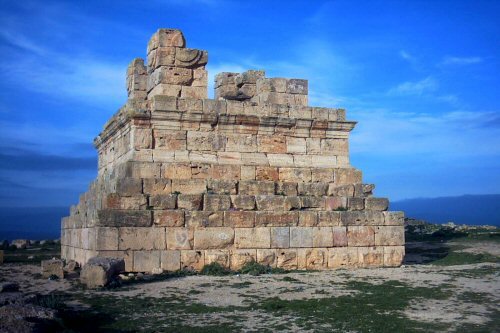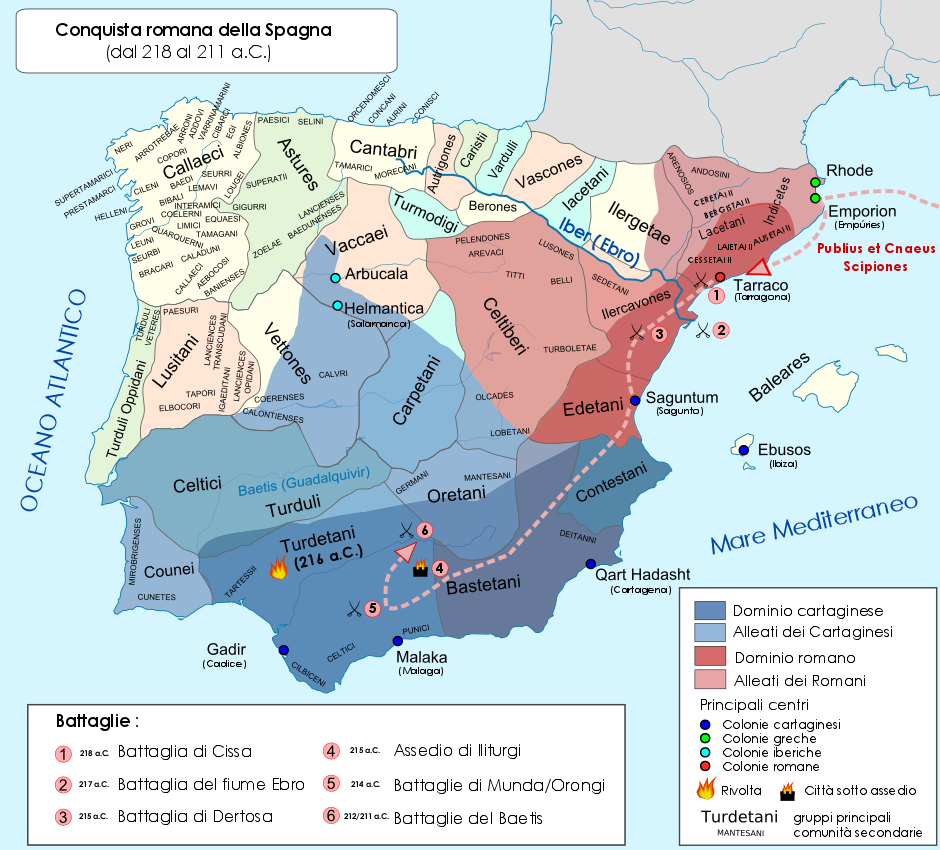|
Capussa
Capussa was a king of the ancient Numidian tribe Massylii in 206 BCE. He was the son of Oezalces who had succeeded his brother, Gala, on the massylian throne. Biography Oezalces had normally inherited the power since he was the oldest prince. When he died, a few months after his arrival, his eldest son, Capussa, was proclaimed king without Masinissa, son of Gala, attempting to assert his rights since in the order of succession, he was just after his cousin Capussa. The reign of Capussa was short-lived. A hostile party was formed by Mazaetullus, a Numidian chief related to the royal lineage but having no rights to the throne. Mazaetullus had married the widow of Oezalces, a Carthaginian, which earned him the support of at least a part of the Punic aristocracy concerned perhaps from this time to remove Masinissa from power, although he has until then faithfully served the interests of Carthage fighting under Hasdrubal Hasdrubal ( grc-gre, Ἀσδρούβας, ''Hasdroúbas'') is ... [...More Info...] [...Related Items...] OR: [Wikipedia] [Google] [Baidu] |
Lacumazes to ask for help; but before reaching the destination, he was attacked by Massinissa, and narrowly escaped capture. From Syphax he obtained auxiliary troops, with whom he joined his guardian, Mazaetullus, and faced Massinissa, but both armies were defeated. Lacumazes and Mazaetullus escaped and took refuge in the court o ...
Lacumazes was a king of the ancient Numidian tribe Massylii in 206 BCE. Biography He was the youngest son of Oezalces and little brother of Capussa. Although when he was still very young, he was put on the throne of the Massylii by Mazaetullus, a Numidian chieftain who dethroned and after killing Capussa. As soon as Masinissa returned to Africa, Lacumazes fled and took refuge in the court of Syphax Syphax (, ''Sýphax''; , ) was a king of the Masaesyli tribe of western Numidia (present-day Algeria) during the last quarter of the 3rd century BC. His story is told in Livy's '' Ab Urbe Condita'' (written c. 27–25 BC). [...More Info...] [...Related Items...] OR: [Wikipedia] [Google] [Baidu] |
Numidia
Numidia ( Berber: ''Inumiden''; 202–40 BC) was the ancient kingdom of the Numidians located in northwest Africa, initially comprising the territory that now makes up modern-day Algeria, but later expanding across what is today known as Tunisia, Libya, and some parts of Morocco. The polity was originally divided between the Massylii in the east and the Masaesyli in the west. During the Second Punic War (218–201 BC), Masinissa, king of the Massylii, defeated Syphax of the Masaesyli to unify Numidia into one kingdom. The kingdom began as a sovereign state and later alternated between being a Roman province and a Roman client state. Numidia, at its largest extent, was bordered by Mauretania to the west, at the Moulouya River, Africa Proconsularis to the east, the Mediterranean Sea to the north, and the Sahara to the south. It was one of the first major states in the history of Algeria and the Berbers. History Independence The Greek historians referred to these peoples as ... [...More Info...] [...Related Items...] OR: [Wikipedia] [Google] [Baidu] |
Massylii
The Massylii or Maesulians were a Berber federation in eastern Numidia, which was formed by an amalgamation of smaller tribes during the 4th century BC.Nigel Bagnall, The Punic Wars, p. 270. They were ruled by a king. On their loosely defined western frontier were the powerful Masaesyli. To their east lay the territory of the rich and powerful Carthaginian Republic. Their relationship to Carthage resembled that of a protectorate. Carthage maintained its dominance over the Massylii by skillful diplomatic manoeuvering, playing off local tribal and kingdom rivalries. The principal towns of the Massylii were Cirta, Tébessa and Thugga in Algeria and Tunisia. Role in the Second Punic War In 218 BC, war broke out between the Carthaginians and the Romans. The Massylii and the Masaesyli, who both possessed a strong and proficient cavalry force, were allied to the Carthaginian cause and performed valuable service for them in Iberia and Italy. In 206 BC, a Massylian prince called Masinissa de ... [...More Info...] [...Related Items...] OR: [Wikipedia] [Google] [Baidu] |
Gala (king)
Gaia (Numidian: ) (died 207 BCE) was an ancient Berber king of the Massylii,Livy, ''Ab Urbe Condita'', 24.48 an eastern Numidian tribe in North Africa. Gaia reigned during the Second Punic War of ancient Rome. He was the father of King Masinissa, and the brother of Oezalces. Greco-Roman authors give his name as "Gala", but an inscription in Dougga Dougga or Thugga or TBGG was a Berber, Punic and Roman settlement near present-day Téboursouk in northern Tunisia. The current archaeological site covers . UNESCO qualified Dougga as a World Heritage Site in 1997, believing that it represents " ... indicates it may have instead been "Gaia". See also * List of Kings of Numidia Notes 207 BC deaths 3rd-century BC Berber people Kings of Numidia Year of birth unknown {{Berber-stub ... [...More Info...] [...Related Items...] OR: [Wikipedia] [Google] [Baidu] |
Masinissa
Masinissa ( nxm, , ''MSNSN''; ''c.'' 238 BC – 148 BC), also spelled Massinissa, Massena and Massan, was an ancient Numidian king best known for leading a federation of Massylii Berber tribes during the Second Punic War (218–201 BC), ultimately uniting them into a kingdom that became a major regional power in North Africa. Much of what is known about Masinissa comes from the Livy's ''History of Rome,'' and to a lesser extent Cicero's Scipio's Dream. As the son of a Numidian chieftain allied to Carthage, he fought against the Romans in the Second Punic War, but later switched sides upon concluding that Rome would prevail. With the support of his erstwhile enemy, he united the eastern and western Numidian tribes and founded the Kingdom of Numidia. As a Roman ally, Masinissa took part in the decisive Battle of Zama in 202 BC that effectively ended the war in Carthage's defeat; he also allowed his wife Sophonisba, a famed Carthaginian noblewoman who had influenced Numidian af ... [...More Info...] [...Related Items...] OR: [Wikipedia] [Google] [Baidu] |
Hasdrubal Barca
Hasdrubal Barca (245– 22June 207BC), a latinization of ʿAzrubaʿal ( xpu, 𐤏𐤆𐤓𐤁𐤏𐤋 ) son of Hamilcar Barca, was a Carthaginian general in the Second Punic War. He was the brother of Hannibal and Mago Barca. Youth and Iberian leadership Little is known of Hasdrubal's early life. He was present, along with his older brother Hannibal, when his father, Hamilcar Barca, died in battle against the Iberians. Hamilcar may have drowned in the Júcar, although the sources do not agree. Little is also known about Hasdrubal's activities during the time Hasdrubal the Fair led the Punic forces in Spain, or during the campaigns of Hannibal Barca in Spain and his Siege of Saguntum. Hannibal left a force of 13,000 infantry, 2,550 cavalry and 21 war elephants in Hispania when he marched for Italy in 218 BC. Hasdrubal commanded this force and he was to set out for Italy in 217 BC to reinforce Hannibal. Hannibal left another army under Hanno in Catalonia, consisting of 10,000 fo ... [...More Info...] [...Related Items...] OR: [Wikipedia] [Google] [Baidu] |
Encyclopédie Berbère
''Encyclopédie berbère'' (English: ''Berber Encyclopaedia'') is a French-language encyclopaedia dealing with subjects related to the Berber peoples (''Imazighen'' in Berber language), published both in print editions and in a partial online version. It was launched in 1984 under the aegis of UNESCO and was originally published by Editions Edisud. Its first editor-in-chief was Gabriel Camps. After his death in 2002, he was succeeded by Salem Chaker, Professor of Berber languages at the Aix-Marseille University Aix-Marseille University (AMU; french: Aix-Marseille Université; formally incorporated as ''Université d'Aix-Marseille'') is a public research university located in the Provence region of southern France. It was founded in 1409 when Louis II o .... Up to 2013, volumes 1 to 36 (Oryx - Ozoutae) have been published online through OpenEdition.org. The online site allows part of the encyclopedia to be viewed in full text and in PDF and offers a search function to key ... [...More Info...] [...Related Items...] OR: [Wikipedia] [Google] [Baidu] |
206 Deaths
6 (six) is the natural number following 5 and preceding 7. It is a composite number and the smallest perfect number. In mathematics Six is the smallest positive integer which is neither a square number nor a prime number; it is the second smallest composite number, behind 4; its proper divisors are , and . Since 6 equals the sum of its proper divisors, it is a perfect number; 6 is the smallest of the perfect numbers. It is also the smallest Granville number, or \mathcal-perfect number. As a perfect number: *6 is related to the Mersenne prime 3, since . (The next perfect number is 28.) *6 is the only even perfect number that is not the sum of successive odd cubes. *6 is the root of the 6-aliquot tree, and is itself the aliquot sum of only one other number; the square number, . Six is the only number that is both the sum and the product of three consecutive positive numbers. Unrelated to 6's being a perfect number, a Golomb ruler of length 6 is a "perfect ruler". Six is a con ... [...More Info...] [...Related Items...] OR: [Wikipedia] [Google] [Baidu] |
3rd-century BC Berber People
The 3rd century was the period from 201 (Roman numerals, CCI) to 300 (Roman numerals, CCC) Anno Domini (AD) or Common Era (CE) in the Julian calendar.. In this century, the Roman Empire saw a Crisis of the Third Century, crisis, starting with the assassination of the Roman Emperor Severus Alexander in 235, plunging the empire into a period of economic troubles, barbarian incursions, political upheavals, civil wars, and the split of the Roman Empire through the Gallic Empire in the west and the Palmyrene Empire in the east, which all together threatened to destroy the Roman Empire in its entirety, but the reconquests of the seceded territories by Emperor Aurelian and the stabilization period under Emperor Diocletian due to the administrative strengthening of the empire caused an end to the crisis by 284. This crisis would also mark the beginning of Late Antiquity. In Persia, the Parthian Empire was succeeded by the Sassanid Empire in 224 after Ardashir I defeated and killed Art ... [...More Info...] [...Related Items...] OR: [Wikipedia] [Google] [Baidu] |



